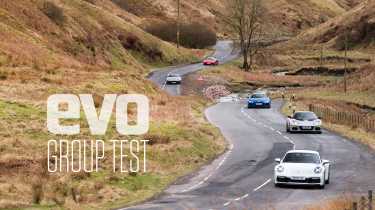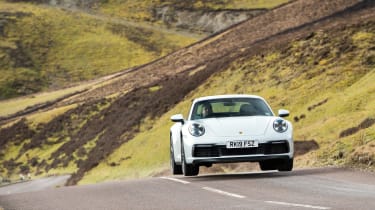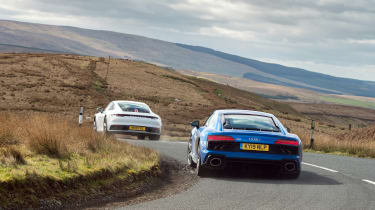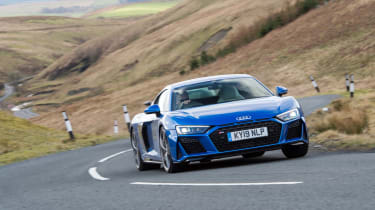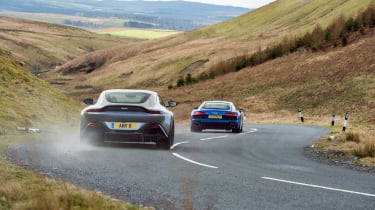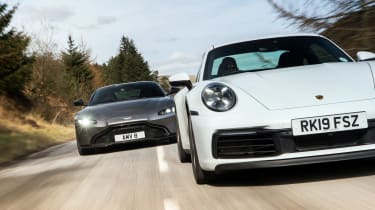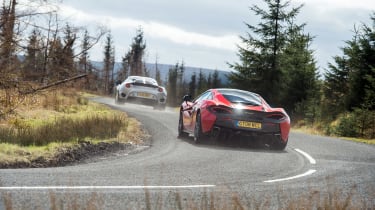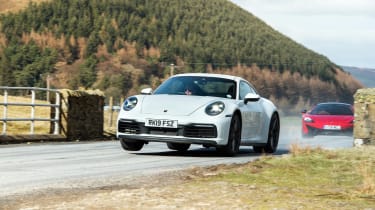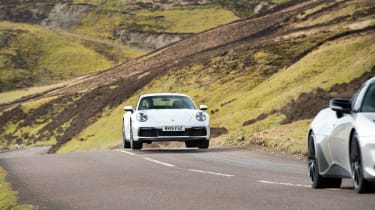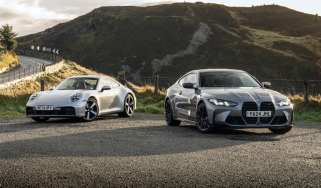Porsche 911 Carrera S vs rivals: R8, Vantage, 570GT and Evora face off
The question is simple. Does the 992-generation 911 Carrera S still have the edge on its core rivals?
There’s nothing quite like the group test of an all-new Porsche 911 to have the weight of responsibility resting heavily on a road tester’s shoulders. And with good reason, for this rear-engined icon has consistently defined a sector of the high-performance market.
Blessed with a near-impregnable combination of qualities that enable it to perform with inspirational brilliance on a challenging road, fit effortlessly into everyday life and feel uniquely special at 15mph or 150, the 911 has long been an industry benchmark.
There’s a more existential reason for the professional angst. Namely the eternal and infernal debate which rages with the introduction of every new generation of 911. We perhaps get too hung up on gazing at our navels wondering what makes a 911 a 911, but if you’re a fan of the breed, this stuff matters. So as if it’s not enough that the 992 has to fight such disparate yet talented opposition (more of which in a moment), it also has to stand nerdy and nuanced comparison with its forebears. Same as it ever was, then.
When it comes to putting an all-new 911 through the mill, evo never skimps. Obviously that’s because we have the contents of countless brown envelopes stuffed with cash and franked with a Zuffenhausen postmark to blow on fancy hotels (that’s a joke, by the way), but also because we’re firm believers in the need for time, miles and context to arrive at a considered verdict. It helps if you also have a diverse and experienced team of testers, in this instance evo veterans John Barker, Jethro Bovingdon and Stuart Gallagher, plus Antony Ingram – a man of few words, but with a clear and astute take on what he likes in a car and why he likes it – and finally yours truly on keyboard duty.
On the road
Our muster point is Biggar, nestled below and between Glasgow and Edinburgh and within striking distance of the Scottish Borders and roads we know well. The journey north gives us plenty of time to get to know our assigned cars. I’ve had the 992 Carrera S delivered to Meaden Towers, Barker is bringing the 570GT and Gallagher the Vantage, while Ingram’s in the R8 and Bovingdon the Evora GT410 Sport. Quite the gathering, and a formidable welcoming committee for the Porsche.
More reviews
Group tests
- Alpine A290 v Alpine A110 – how much DNA do they really share?
- Ariel Atom 4R v Caterham Seven ‘evo25’: power-to-weight heroes go head-to-head
- Aston Martin Vantage vs Audi R8 V10 RWD – back to basics
- Caterham Super Seven 600 v Super Seven 2000
- Levante v T1
- Corvette Stingray v Porsche Cayman GTS v Audi R8 RWD
- Great Ferrari hypercars driven: 288 GTO, F40, F50 and Enzo head-to-head
- Lamborghini Aventador Ultimae v Lamborghini Countach
- Lotus Emira v Morgan Plus Four – four-cylinder Brits go head-to-head
- Toyota GR86 v BBR Mazda MX-5: supercharged drop-top battles sports coupe
In-depth reviews
- Abarth 600e 2025 review – Italy gives the Alpine A290 something to worry about
- Alpine A110 review – distinctive, lightweight and unforgettable to drive
- Audi RS7 Sportback Performance review
- Bentley Continental R Mulliner: review, history and specs
- BMW 5-series review – is this still Munich’s anchor model?
- BMW 1-series review – Munich’s Audi A3 rival gains focus
Long term tests
- Abarth 695C Turismo Fast Fleet test – 10,000 miles in the Italian hot hatch
- Alfa Romeo Giulia Veloce Fast Fleet test – 7000 miles in the sharp Italian saloon
- Alpina B10: end of term report
- Alpina B10
- Ford Mustang GT
- Ford Mustang GT
- Ford Mustang GT
- Land Rover Defender 110 Fast Fleet test – 9000 miles in the go-anywhere SUV
- Maserati Ghibli Trofeo Fast Fleet test – 4000 miles in the Ferrari-powered saloon
- Mitsubishi Evo MR 340
Review
- New Aston Martin DBS 770 Ultimate review – 759bhp super-GT driven
- New Bentley Batur 2023 review – can it possibly be worth £1.65m?
- 2023 Chevrolet Corvette C8 Z06 review – the American 911 GT3?
- Kia EV6 GT-Line S prototype review – the EV that shows how it’s done
- BBR Supercharged Mazda MX-5 (ND) 2023 review – tuned 250bhp roadster driven
- MG4 Trophy 2023 review
Reviews
- Abarth 695 75 Anniversario edition 2024 review – a fitting send-off for Abarth’s hot supermini?
- Abarth 500e 2023 review
- AC Cobra 378 Superblower MkIV 2021 review – another V8 Cobra, but with a GM heart this time
- Acura Integra Type S 2024 review – a Honda Civic Type R with added restraint
- Alfa Romeo Giulia 2025 review – get one while you still can
- Alfa Romeo SZ: history, review and specs of an icon
- Alfa Romeo 1750 TBi
- Alpina B3 GT Touring 2025 review – a 190mph alternative to the BMW M3 Touring
First impressions of the 992 are mixed. The proportions are true to the 911 stamp, but the scale is quite a shock. Especially when I park my own 964 next to it for comparison. It’s absolutely dwarfed by the new car, which combined with the new full-width rear light treatment makes me think – rather uneasily – that the 992 could almost pass as a Panamera Coupe.
The interior is a bigger shock. It’s beautifully clean, with crisp lines and a heavy reliance on bright display screens, but I feel a bit lost as there’s little to link it to 911s of the recent past. The new PDK selector sprouting from the transmission tunnel has the stubby appearance of a Jack Russell’s docked tail. It’s apologetic and strangely out of place in a 911, though quite why I’m not sure.
The 992 munches through motorway miles with the loping gait of a big saloon. There’s still some tyre noise on coarse surfaces, which is disappointing as this has long been a 911 bugbear, but the big luggage compartment in the nose and vestigial rear seats make the 992 a practical everyday proposition and a great long weekend companion.
Barker, Gallagher and I form a convoy up the A1(M), so as well as using the miles to familiarise myself with the 992 I get to see the 570GT and Vantage mixing it amongst the flow of humdrum metal. Both look spectacular, the svelte scarlet McLaren slicing through the traffic, while the steel grey Vantage is all biceps and shoulders, muscling its way along like a scrum-half. The 992 doesn’t have their presence, but it definitely gets attention.
We arrive at our hotel to find the Evora and R8 already parked up. Two more different mid-engined machines you couldn’t wish to see. It’s normally reasonably easy to predict how a test will pan out, but if conversation over dinner and a few beers is a gauge of our collective predictions, all bets are off.
Next morning dawns cold and clear. Perfect conditions for that great group test ritual: the synchronised start-up. It’s a helluva noise as all five cars flare with revs before settling into elevated idles as engines slowly warm, clouds of exhaust vapour swirling into the chill air. No matter how many times I witness it this always makes me smile.
I’ve been a fan of the R8 since it was first launched, and was lucky enough to live with a late previous-generation V10 Plus (with manual transmission!) as an evo long-termer, so I suppose it’s inevitable that I’m drawn to the Audi. It looks fabulous outside and in; discreet but still with a touch of concept car about it, together with a quality feel and ergonomics that make everything seem totally intuitive.
You sit a bit high, which is a shame, but the view out is pure supercar thanks to the panoramic forward view and the rising wheelarches that sit like high cheekbones in your peripheral vision. The flat-bottomed steering wheel sits nicely in your hands, but the small plastic shift paddles (actually more like flat buttons) seem a bit VW parts bin. The same can’t be said for the V10 motor, which manages to be mellow and menacing at the same time and really creates a sense of occasion.
The steering (standard rather than Dynamic) is light but calm. In fact it’s surprisingly out of step with the current vogue for hyper-responsive steering and can initially feel a bit slow-witted as a result, but personally I prefer this to racks with more aggressive ratios. This particular car also has passive dampers (Magnetic Ride is a £1700 option), which lends a satisfyingly rounded feel to the way it tackles any given road. You can wind some aggression into the powertrain with dynamic modes, but otherwise this is a fuss-free car that just encourages you to settle in and get on with it.
There’s a depth of quality to the R8 that goes beyond chassis set-up and powertrain. It always feels special – a model crafted to sit apart from every other car Audi builds – but it’s also measured in everything it does. Some people might think of it as the Clarke Kent to the Huracán’s Superman, but the R8 is no watered-down Lambo.
Proof of that comes when you extend the V10, which has a silken character but searing performance, and a nicely serrated edge at the top end. It’s a real force of nature through the gears, and there’s real big-capacity muscle that lets you hold a tall gear and stretch it as far as you need.
The roads in this part of the world are pretty special, but also pretty demanding, with some sections an apparently endless succession of crests and compressions that resemble a tarmac mogul field. The R8 maintains admirable composure most of the time, but it takes a couple of awkwardly spaced whoops to betray the weight of that V10 and test the bump and rebound properties of the suspension. Every now and again you get a feeling of the tail still rising as the nose is falling, at which point you have to momentarily breathe out of the throttle and let everything settle. Up ahead, the 992 skips like a well thrown pebble does across water, but from earlier experience I know it feels more serene than it looks.
Bov and I are big fans of the V10, but Barker resolutely refuses to get over Audi ditching the V8 and stick-shift. He has a point, for the big motor can feel ever so slightly pendulous, but given the 992’s muted soundtrack and the V10’s naturally aspirated response, I’d say it’s a price worth paying. The R8 also has an uncanny level of motorway refinement – not something you’d expect from a 562bhp mid-engined supercar, but a quality that makes it supreme on a long journey and proves you don’t have to sacrifice character or a soaring engine note to achieve such things.
If the Audi is a paragon of measured restraint, the Aston is a real party animal. The looks have drawn some criticism, largely due to the front end’s trout pout, but in this brooding shade of steel grey (courtesy of Aston’s bespoke department, Q), with some carbonfibre detailing and crackle-finish rims, it’s by far the best-looking Vantage I’ve seen.
The driving experience is as unambiguous as the squat stance and pumped-up curves, with that pummelling AMG-sourced, AML-tweaked 503bhp 4-litre biturbo V8 quite literally front and centre, and a deliberately aggressive chassis set-up. It’s great to have a ballsy front-engined, rear-drive car mixing it with the mid- and rear-engined exotica, for the way in which it goes down the road is in stark contrast to the others.
The interior is like a fighter cockpit, with high shoulders and a blizzard of switches that pepper the centre console. It’s busy, but makes more sense with time and fosters a compact feel, even if this Vantage is significantly broader than the beautifully compact car it replaced.
There’s an energy and urgency about this car that’s completely infectious. From the moment the ballsy motor booms into life you know you’re in a serious sports car. One that makes you want to roll up your sleeves and get stuck in. The steering is as alert as the Audi’s is relaxed, so although it initially takes you by surprise, you soon learn to pare back your inputs and trust in the front end’s bite.
There’s massive grip to lean on, and with the near-instant snap from the torquey turbo’d V8 you’re encouraged to work both ends of the car and play with the balance. It feels rampantly potent, each upshift thumping you down the road with addictive force, but the auto transmission can’t match the speed or precision of the twin-clutch ’boxes here, and doesn’t generate any engine braking, so you’re either hard on the gas or hard on the brakes.
Nevertheless, after the aloof 992 and the considered Audi it’s a real thrill to drive a car that wants to party at every opportunity, even if the hot-rod vibe sometimes jars with Aston’s cultured brand image. How you view the Vantage’s shortcomings has a polarising effect on your overall impression of the car. There’s no doubt you feel it reach the limits of its damping earlier and in a more pronounced manner than the others – it lacks ultimate vertical control and breaks traction more sharply – but don’t be under the misapprehension that this means it’s anything short of an extremely quick and capable car.
If, like me, you’re of the opinion that today’s high-performance cars are way too fast to be readily or responsibly pushed to their limits on the road, then you’ll enjoy the fact that the Vantage isn’t impervious to the challenges presented by the road beneath it. It makes it a more freely expressive machine, one that entertains, engages and challenges you more of the time. I will have my most enjoyable drive at this test in the Aston, but that doesn’t blind me to its weaknesses.
Of all the cars here the 570GT is the most weapon-like, which given this is Woking’s idea of softcore says a lot for McLaren’s take on things. To be honest, I’ve taken a long time to warm to McLaren’s portfolio of models, but as the brand has matured and the products have evolved there’s no doubt a confident and distinctive family of cars has emerged.
Red is a provocative colour for a Ferrari rival, but the GT carries it off well. It’s a sexy-looking thing with some quirky details, such as the E-type-style side-hinged hatchback. That it opens onto little more than a parcel shelf is a bit disappointing, but what do you expect when there’s a twin-turbo V8 tucked amidships?
Lift the dihedral door and limbo your way into the driver’s seat and the cockpit is light and airy, though the infotainment system is pretty shonky and secondary switchgear infuriatingly counter-intuitive. It aspires to be the Porsche or Audi, but isn’t there yet.
The motor is a bit industrial and thrummy in tone, but it’s ferociously powerful and the transmission is every bit as good as the Porsche or Audi’s. There’s a degree of occasion and drama to simply being in the 570GT, but what sets it apart is its ball-tearing, mouth-parching, breath-stealing pace. There’s some minor turbo lag, but once the 562bhp 570 is fully lit, it’s rampantly quick.
There’s a delicacy to the steering and a palpable sense of lightness about the whole car that separates it from the rest here. Where the 992 feels like a solid slab of a car with overly heavy steering and the R8 feels a little soft-edged and dialled-back in its responses, the McLaren is all about its synaptic steering and fast-twitch handling.
This fosters a sense of grip and agility at low and medium speeds, but personally I find it too responsive when you’re really digging deep. It rotates as though impervious to the effects of inertia, but this means you need calm hands and precise inputs. Grip the wheel tight, as you might in such a fast and flighty machine, and you’re not relaxed enough to let it flow. Steal yourself to cup the wheel gently in your palms and you feel the wheel continually chase bumps and cambers. I struggle to trust it fully, but Bov and Ingram love it.
It’s an edgy, adrenaline-charged experience, but one tempered by traction control that feels the need to hold the 570GT back well into fourth gear, often in a straight line. You can slacken it off to a degree via the Active controls, but such is the nature of McLaren’s driver interface I suspect even Alan Turing would struggle to fully disable the traction and stability control system while on the move.
More than any other car here the McLaren makes me question the need for cars to be this darned quick. Even on roads that would make an Impreza 22B worry for its sump pan. I’d like to think we’re all broad-minded enough to accept there are times when you can let loose in these cars, but with one concerted lunge through the gears a 570GT will readily hit speeds that are genuinely obscene. I’ve come to the conclusion I simply don’t need or want to go that fast.
The Evora GT410 Sport is an unlikely antidote, but within a handful of miles you know it possesses all the qualities that have been swept away in the pursuit of evermore irrelevant performance. Yes, this Lotus is loooong in the tooth, and despite its concessions to practicality and 2+2 seating, sticking it in this test is like bringing a Caterham Seven to compare against an MX-5. Yet once you commit yourself to spending some time in the Evora not only is it nowhere near as arduous an experience as you’re expecting, it also reconnects you with the things the others purport to offer, but actually fall a little short of delivering.
Despite the humdrum origins of the engine and gearbox there’s a lot to like. So what if the trombone-like exhaust note is a bit mouthy for some (don’t tell anyone, but I rather liked it) and the manual gearshift can be a bit snaggy? The steering is magnificent, for feel, physicality and rate of response, and the damping has exceptional breadth, being both super-supple and ultra-controlled. The power delivery from the 410bhp supercharged V6 is gutsy and the performance is perfectly matched to the available grip.
It has the polish of the Porsche but with an abundance of character and a deep sense of connection. In many ways it shames the others, for it shows how far they have strayed from the path of purity and simplicity. Given I’d bet my boots most people with a new R8, 911, 570GT or Vantage also have another car (probably a big, comfy SUV) I’d question the need for these cars to be quite so habitable. Still, I’ll readily admit the Evora demands a mindset more akin to that of a motorcyclist. It’s a mega car, but too pared back for most tastes.
It’s extremely rare for a group of cars to divide opinion in quite the manner of this quintet. You wouldn’t expect, nor want, five experienced testers to arrive at a unanimous decision, but you could reasonably expect a clear consensus. Yet as we each grapple with our own finishing orders it becomes increasingly apparent we are all as conflicted over our own choices as each other.
The Lotus is the intentional outlier in this test. Less a serious contender and more a palette cleanser between the four main protagonists, it offers a dynamic reference and a sensory reset. We all thoroughly enjoyed its analogue tactility and immersive qualities – the manual gearbox alone brought a welcome added dimension to every stint – while its grip, damping, braking and agility unfailingly highlighted how simplicity and low mass are at the heart of a great sports car. Whatever direction Geely decides to take with this great brand we sincerely hope it cherishes the Chapman ethos and strives to ensure that lightweight DNA survives the metamorphosis Lotus is about to undergo.
The verdict
The biggest bombshell of this test is that none of us has the 992 top of our lists. Barker and Bovingdon have it in second place, while I have it joint second with the Aston. Remarkably, Gallagher and Ingram have it last, though by their own admissions this doesn’t make it a bad car. Far from it, in fact. Indeed if there’s one thing we’re all agreed on it’s that the 992 is perhaps a little too good for it’s own good.
By the end of the test there’s a shared feeling that the 992 marks the tipping point at which the 911 really has become too big. However, the thing that undermines its challenge is the way it hides its sporting character beneath a deep layer of Panamera-style maturity and sophistication. Porsche has stated there will be a big focus on special editions and GT models, and while this sounds exciting, it also confirms what we’ve discovered: that the base models don’t have the innate effervescence and unmistakable character that historically sat so close to the surface with the humble Carrera. The 992 possesses greatness, but you have to dig too deep to reveal it.
Another car to divide us is the Vantage. Gallagher has it top of his finishing order, Ingram third, Barker joint third with the McLaren, and Bovingdon bumping it to fourth. Much like the 992, the discrepancies are down to the divergent appeal of capability and character. Zero in on its shortcomings – in particular that soft-edged transmission and the lack of vertical body control when really going for it – and you have to concede the Vantage lacks the polish and outright prowess of the R8, 992 and 570GT. But… if instead you pause to consider how much you enjoy driving it, how accessible that enjoyment is and what impact the dynamic shortcomings have when you’re not probing the limits, then you find yourself entirely smitten by the ebullient Aston’s ability to entertain at less than loony levels of commitment.
Speaking of loony, what of the 570GT? Exotic looks, delicate controls and a genuine sense of lightness set it apart in this company, as does its searing point-to-point speed. Unleashing it on a country road is akin to rocking up at your local flying club in a Eurofighter Typhoon, but the frustrating infotainment system, fiddly secondary switchgear and creaky trim is enough to taint the overall experience, for me at least. No car can inspire and infuriate quite so readily as a modern-day McLaren.
And so to the R8. It’s ironic that a car so clearly inspired by Audi’s desire to have a 911 of its own should supplant the Porsche, but it’s proof that character and capability are not mutually exclusive. No, it doesn’t quite hit the giddy individual heights of the McLaren’s ruthless speed, the 992’s unerring poise, or the Aston’s boisterous delivery, but it comes close enough. Crucially, it does so while delivering a driving experience that’s very much its own.
In boxing parlance it wins on a narrow majority decision rather than a knockout blow. Hot on its heels are the McLaren, Vantage and 992 – respectively the quickest, most characterful and most capable cars in the test, and proving almost inseparable despite being chalk and cheese. The Evora follows in their wake, beaten in all the areas you’d expect (though far from given a drubbing) yet triumphant in terms of purity and connection.
There’s no doubt we’ve become conditioned to 911s winning tests like this, but still, this feels like a pivotal moment. The early 991 was clearly sub-par thanks to issues centred on its steering feel and response, but it eventually found its feet. The 992 is an immaculately polished machine straight out of the blocks, but in a way that makes its failings more troubling because they are rooted in its excessive size, subdued turbocharged engine and a general lack of character and sparkle unless you’re really wringing it out. There’s no question the 992 is an exceptionally able car. Only time will tell whether Porsche can make it into an exceptional 911.
